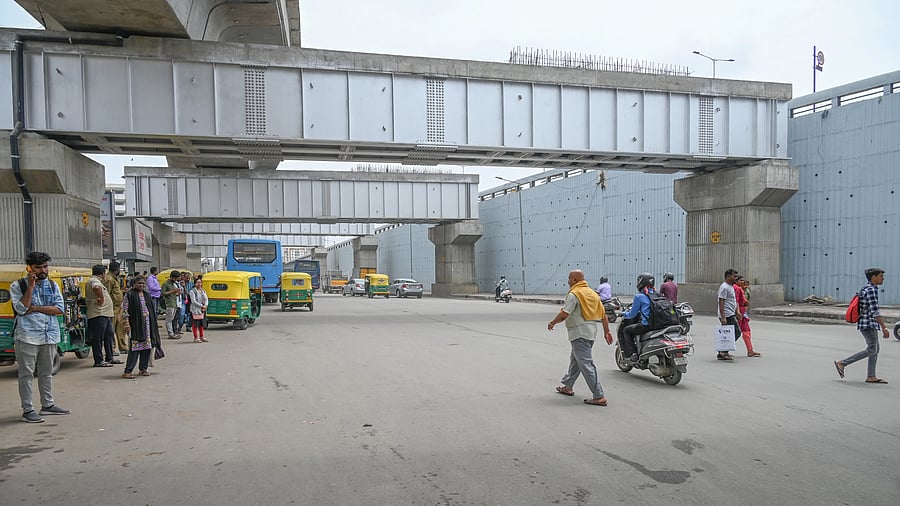
At least 25 feeder buses are required from metro stations to the five tech parks located along the ORR every 2.5 minutes from 8 am to 10 am and from 5 pm to 7 pm.
Credit: DH Photo/S K Dinesh
The massive gridlock commuters faced along the Outer Ring Road (ORR) on September 27 has not only drawn criticism but also reignited a long-standing discussion about expanding public transport and encouraging more people to adopt it.
Earlier this year, the much-awaited KR Pura-Whitefield extension of the Purple Line was opened to the public. But a missing link between KR Pura and Baiyappanahalli meant commuters had to rely on feeder buses between the stations. Oftentimes, these buses were infrequent and already packed with commuters, making it a very cumbersome mode of transport.
However, the link between the two stations is finally set to open in the first few days of October and there is a widespread hope that the completed line will not just help employees and residents in the far east of the city easily reach destinations to their west, but also reduce the traffic burden on the ORR.
BMRCL Managing Director Anjum Parwez earlier told DH that they expect the Purple Line ridership to rise by 75,000 once both links (Baiyappanahalli-KR Pura and Kengeri-Challaghatta) open. The metro’s average daily ridership in September was 6.30 lakh.
Campaign leads the way
To make this possible, the Personal 2 Public campaign launched by B.PAC and WRI India has been encouraging people to shift from their personal vehicles to public transport at least twice a week.
The campaign has identified nearly 3,75,000 employees owning 1,91,000 private cars in the top five tech parks along the ORR, spaced out between 2.6 km to nearly 10 km from the KR Pura metro station.
To reduce the number of these cars and encourage the use of the metro, it has recommended running 25 feeder buses from the metro station to each of these tech parks every 2.5 minutes from 8 am to 10 am and from 5 pm to 7 pm.
The campaign has also suggested potential feeder bus routes between Garudacharpalya and Seetharampalya metro stations via Marathahalli and Brookefield; Kundalahalli and Sri Sathya Sai Hospital stations via ITPL Main Road; from and to Vydehi Hospital through Varthur and Whitefield; and from and to ITPL through Whitefield and Immedihalli Khane.
Currently, the BMTC runs 15 feeder buses between Baiyappanahalli and KR Pura stations every day, ferrying 8,000-10,000 people. The cost per kilometre (CPKM) is Rs 80 while the earning per kilometre (EPKM) is Rs 70.
“Rs 70 is a very good EPKM,” a senior BMTC official said.
Once the Baiyappanahalli-KR Pura metro link opens, the BMTC will stop the feeder bus services on this route and divert them to the ORR in a bid to connect more people to this metro line.
Two routes are under consideration. One is the KR Pura metro station to the same point, spanning a route length of 15-16 km. The second route under consideration is from KR Pura to Silk Board Junction, along the ORR, with AC feeder buses for employees of tech parks.
Impact on Vajra
The BMTC is evaluating the potential impact on its Vajra (Volvo air-conditioned bus services) that ply to various destinations in and around Whitefield.
“We are closely observing the situation and will take a call depending upon the situation,” G T Prabhakar Reddi, Deputy Chief Traffic Manager, BMTC, told DH.
M N Anucheth, Joint Commissioner of Police (Traffic), said the true impact of the complete line and the shift from personal vehicles to metro or other modes of public transport can be ascertained after at least a month of metro operations.
“It all depends on how many people shift to the metro and how getting to the metro is made accessible for them. So the impact is yet to be seen but of course, we expect the traffic to reduce along Old Madras Road and in and around K R Pura,” he said.
Kuldeep Kumar Jain, Deputy Commissioner of Police (Traffic, East), was also unsure about the impact of the metro on traffic along the ORR.
“I expect this to really help IT employees and residents in and around Whitefield but I am not so sure about how it will impact traffic on the ORR. I suppose the average commute time on the ITPL Main Road and other roads around it might come down by 10-15%,” he said.
He added that the traffic police might conduct a scientific study to understand the traffic impact of the metro in a few weeks if needed, but the focus of his personnel is to ensure that, private vehicles or not, traffic movement occurs faster and without a hitch.